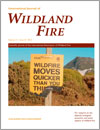International Journal of Wildland Fire
Volume 21
Number 8 2012
We combine a physical wildfire model with population data via a cost function and use it to examine decision-making in the context of simultaneously occurring wildfires in different conditions. We examine tradeoffs for one, two and ten fires, and compare ad hoc strategies with the cost optimisation strategy.
This paper presents a vision-enabled wireless sensor network node for early detection of forest fires. By integrating a prototype smart imager with a commercial wireless platform, we endowed the resulting system with vision capabilities and radio communication. Tests confirmed the high degree of reliability of our approach.
Suppression firing is a technique frequently used in wildland firefighting. Experimental fires were conducted in shrubland to model the effects of flame-front interaction on the rate of spread of heading and suppression fires. The model reflected the observed moderately low acceleration in the rate of spread of fronts and the short distances over which interaction occurred.
The goal of this study is to quantify firebrand production from a full-scale burning structure. The firebrand size and mass were determined and compared with historical investigations as well as firebrand generation data collected from burning vegetation by the authors.
The aim of this study is to compare the effectiveness of different fuel treatments applied in a mixed heathland in NW Spain to reduce fire hazard, by assessing the flammability of the resulting vegetation in laboratory tests.
This study utilises a long-running experiment in Queensland, Australia, to determine the effects of frequent prescribed burning undertaken from 1952 to 2007. Annual burning reduced the density and richness of woody understorey plants >1 m in height, but most species persisted through resprouting mechanisms (e.g. lignotubers), demonstrating a high degree of resilience to frequent burning regimes.
Through utilising a field experiment in south-eastern Queensland, Australia, we found that certain herbicide treatments are likely to be useful for manipulating fuels (understorey fine-fuel biomass, fuel structure and composition) before prescribed fire in young pine plantations, because certain treatments minimised tree scorch height during prescribed burns.
This study evaluated the influence of fuel treatment, tree size and species on tree mortality following a large wildfire event that involved recent thin-only and thin and prescribed burn units. The study contributes further evidence of the effectiveness of thinning and prescribed burning on mitigating post-fire tree mortality.
Predictive models of burn probability and burn severity were constructed to improve understanding of the factors limiting fire activity in desert spring environments. Burn probability was greatest in lush wetlands and near anthropogenic ignition sources. Burn severity was greatest in relatively unaltered areas with dense woody vegetation.
In this work, two methodologies (logistic regression and neural networks) and different combinations of input parameters (including land surface temperature (LST), vegetation indices and fire history) have been analysed for fire danger estimation. LST seems to be the best indicator of fire danger and neural networks the best methodology to apply.
In order to help fire agencies in the allocation of resources, we present and validate a new wildland fire index, specifically adapted to a Mediterranean region, to map the daily probability of fire occurrence. Multi-criteria methods were used to incorporate experts’ opinion in the aggregation and weighting of risk components.
A numerical model was developed to explore how variation in leaf traits could alter the transmission of wildfires. Here we investigate effects of naturally occurring tissue phosphates, which are fire retardants for natural fibres. Phosphate effects were predicted to be modest compared with other leaf characteristics.
This paper delineates zones with a homogeneous fire regime across Canada and compares these zonations with the multipurpose National Ecological Framework for Canada. Results showed that the National Ecological Framework for Canada was unable to delineate regions with particular fire regimes as opposed to homogeneous fire regime zonations.
There are possible negative effects on human health caused by large wildfires on communities near and downwind of the fire, particularly when more than 2000 acres (809 ha) are burned per day. Most of the PM10 exceedances occurred at sites closest to and east of the fire, none in the San Joaquin Valley. The highest 2-week average O3 concentrations occurred in the eastern part of the Sierra Nevada and north of the fire. Large fire size and high fire intensity in combination with urban pollutants from the Central Valley may be the leading cause of increased concentrations of ozone and particulate matter in rural mountain communities of the Sierra Nevada.




